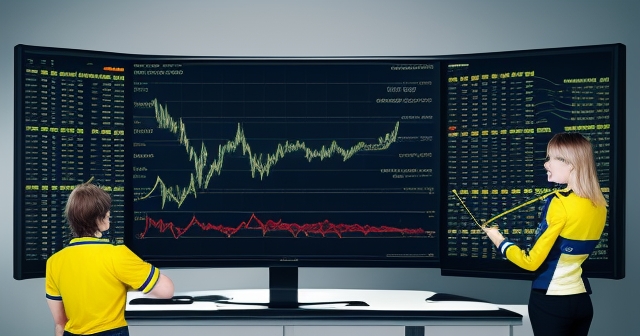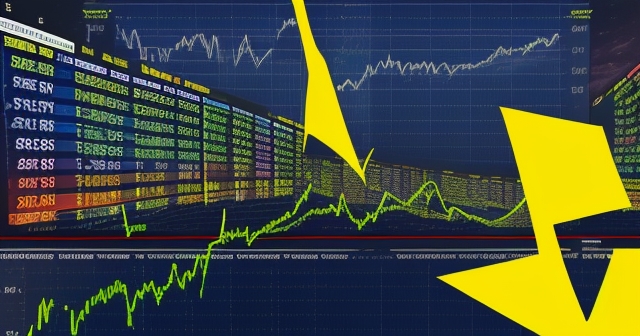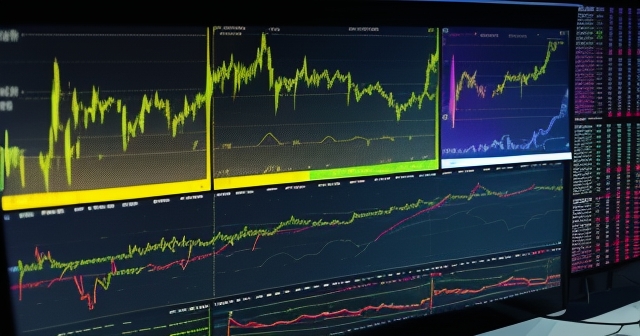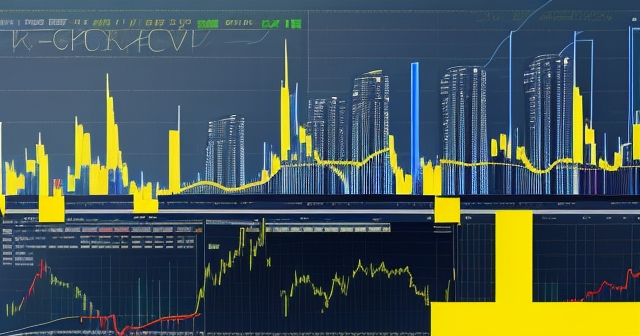Understanding the Swedish Krona (SEK): Navigating Recent Rallies, Forecasts, and the Digital Frontier
The world of foreign exchange, or forex, is a dynamic environment where currency values constantly shift based on a complex interplay of global and local factors. Among the G10 currencies, the Swedish Krona (SEK) has recently captured significant attention, demonstrating a notable surge against major counterparts like the US Dollar (USD) and the Euro (EUR). This performance marks a potentially interesting turn following periods of relative stability or even weakness.
If you are an investor just starting your journey or a trader looking to deepen your understanding of technical analysis and macroeconomic influences, analyzing the SEK offers a valuable case study. We’ll explore the reasons behind this recent strength, examine expert forecasts, delve into the domestic economic picture, and even look at Sweden’s pioneering steps towards a digital currency. Consider this your comprehensive guide to understanding the forces shaping the Swedish Krona today.

The Krona’s Remarkable Rally: Quantifying Recent Strength
Over the past few months, particularly since late January and early February, the Swedish Krona has shown impressive resilience. It has appreciated significantly against many of its G10 peers, standing out alongside the Japanese Yen as a top performer. How significant is this movement? We’ve seen the SEK gain over 5% against the US Dollar and more than 3.5% against the Euro in this relatively short period.
To put this into perspective, let’s look at specific currency pairs. The USDSEK pair, which measures how many Swedish Kronor you need to buy one US Dollar, recently traded around 10.7361 as of mid-February. This is a considerable retreat from its all-time high of 11.50 reached in September 2022. Similarly, the EURSEK pair, showing the Euro’s value in Kronor, has also softened, although forecasts suggest it may trade above 11.00 for much of 2025, indicating the recent move is challenging that level but might not sustain easily in the very near term.
| Currency Pair | Recent Trading Value | Historical High |
|---|---|---|
| USDSEK | 10.7361 | 11.50 (Sep 2022) |
| EURSEK | Challenging 11.00+ | Not specified |
Understanding these shifts is crucial for anyone involved in currency trading. It highlights how quickly sentiment and economic data can translate into price action, presenting both opportunities and risks. How can we account for such a swift change in momentum?
Global Tailwinds: How European Sentiment and US Data Drive SEK
The performance of a smaller, open economy’s currency like the Swedish Krona is often heavily influenced by the global economic climate and the performance of major economic blocs. In the case of the recent SEK rally, two significant external factors appear to be playing a crucial role:
- Improving European Sentiment: The Swedish economy is closely linked to the Eurozone. When sentiment towards the broader European economic picture improves, it often spills over to Sweden. We’ve seen this reflected in the performance of European equity markets, like the Euro Stoxx index, which has recently outperformed its US counterparts like the S&P500. This ‘risk-on’ mood towards Europe makes investors more comfortable holding European assets, including the Swedish Krona. Discussions around potential geopolitical improvements, such as hopes for a peace deal in Ukraine, or anticipation of EU spending plans, can further bolster this sentiment, indirectly benefiting the SEK.
- Softer US Economic Data and Fed Expectations: On the other side of the Atlantic, recent US economic data has shown signs of softening. This has led markets to adjust their expectations regarding the US Federal Reserve’s future interest rate path, often referred to as ‘dovish repricing’. When the prospect of Fed rate cuts increases, it can weaken the US Dollar. Since SEK often exhibits a negative correlation with US data surprises (meaning SEK strengthens when US data disappoints) and US yields (meaning SEK strengthens when US bond yields fall), this shift in the US economic narrative has provided a significant boost to the Krona against the Dollar.

Think of it like sailing: while your boat (the SEK) has its own engine (domestic factors), the strength and direction of the global currents (European sentiment, US data, major central bank policies) have a huge impact on your overall speed and destination. These external forces have provided a powerful push for the Krona recently.
Domestic Resilience: Sweden’s Improving Outlook and the Riksbank’s Stance
While global factors are important, the domestic economic situation in Sweden and the monetary policy actions of its central bank, the Riksbank, are foundational to the Krona’s value. Recent data suggests that the Swedish economy, which faced headwinds, is showing signs of recovery, and the Riksbank’s policy is evolving.
The Riksbank has been active in adjusting its interest rate, having delivered 175 basis points of rate cuts from its peak. These cuts, while aimed at supporting the economy and households, also influence the attractiveness of holding SEK-denominated assets. However, the Riksbank’s primary focus remains on bringing inflation back to its 2% target. While the inflation rate (CPIF) stood at 1% in January, forecasts anticipate a rebound to 2.7% ahead, keeping the Riksbank vigilant.
| Economic Indicator | Current Status |
|---|---|
| Construction Output | Showing signs of improvement |
| Retail Sales | Potentially subdued but recovering |
| Business Confidence | Improving sentiment noted |
| Housing Market | Starting to rebound |
Crucially, several economic indicators paint a picture of nascent recovery:
- Construction Output & Industrial Production: These sectors are showing signs of improvement, indicating a potential pickup in economic activity.
- Retail Sales & Household Spending: While still potentially subdued, any signs of recovery here are vital for domestic demand.
- Business and Consumer Sentiment: Surveys measuring confidence among businesses and consumers have shown improvement. This is a forward-looking indicator that can signal future spending and investment intentions.
- Housing Market: There are reports of the housing market starting to rebound after a downturn.
When Sweden’s economic outlook improves, particularly relative to the Eurozone, it can provide fundamental support for the SEK, making it more attractive to international investors. The interplay between the Riksbank’s efforts to manage inflation and support growth, coupled with these improving domestic indicators, creates a complex but increasingly positive backdrop for the currency.
Krona Forecasts and Valuation Outlook: What the Experts See
Predicting currency movements is notoriously challenging, as it involves weighing countless variables. However, financial institutions and data providers offer forecasts based on their models and market analysis. What are they saying about the Swedish Krona?

Looking at the USDSEK pair, Trading Economics models forecast it at 11.21 by the end of the current quarter and 11.55 in 12 months. This suggests an expectation that the recent SEK strength against the USD might moderate, with the pair potentially moving back towards higher levels over time. Remember the September 2022 high of 11.50 – these forecasts hint at a potential return to those highs within a year.
For the EURSEK pair, ING analysts forecast that the pair is likely to trade above 11.00 for most of 2025. While short-term dips below 11.00 are possible, their view suggests that holding below this level might be challenging over an extended period. This forecast implies that the recent rally pushing EURSEK lower may face resistance.
| Currency Pair | 12-Month Forecast |
|---|---|
| USDSEK | 11.55 |
| EURSEK | Above 11.00 |
Medium-term analysis, based on fair value models, suggests that the EURSEK pair might still be somewhat undervalued in the short term, indicating potential for further appreciation of the SEK. However, the longer-term outlook suggests a potential gradual depreciation towards its estimated fair value, which is roughly 10% below current levels. This highlights a potential divergence between short-term market dynamics and longer-term fundamental valuation.
Upcoming economic events will be critical for validating or altering these forecasts. Major data releases like the European Central Bank (ECB) meeting, Sweden’s next inflation print, and US payroll data can all introduce volatility and potentially shift market expectations for interest rates and economic growth, impacting SEK pairs.
Understanding Currency Pairs: How SEK is Traded in the Forex Market
For investors and traders, interacting with the Swedish Krona typically happens through currency pairs in the forex market. A currency pair, like EUR/SEK or USD/SEK, represents the value of one currency against another. The first currency listed is the ‘base currency’, and the second is the ‘quote currency’. For example, in EUR/SEK, the Euro is the base currency, and the Swedish Krona is the quote currency. The price tells you how much of the quote currency is needed to buy one unit of the base currency.
Major SEK pairs include:
- EUR/SEK: The most traded SEK pair due to geographical proximity and economic ties with the Eurozone.
- USD/SEK: Influenced by global risk sentiment, commodity prices, and the relative monetary policy stances of the Riksbank and the US Federal Reserve.
- GBP/SEK: Reflecting the economic relationship and monetary policy differences between Sweden and the United Kingdom.

Trading these pairs involves speculating on whether the value of the base currency will strengthen or weaken relative to the quote currency. This requires understanding the economic drivers of both currencies in the pair, as well as broader market sentiment. The forex market operates 24 hours a day, five days a week, offering significant liquidity and opportunities, but also requiring careful risk management.
If you’re just considering wading into the waters of forex trading or looking to expand your portfolio beyond traditional assets, learning how to analyze and trade currency pairs like those involving the SEK is a valuable step. The technical and fundamental skills you develop are applicable across different markets.
If you’re considering beginning your journey in forex trading or exploring a wide range of CFD instruments, then Moneta Markets is a platform worth considering. Based in Australia, it provides access to over 1000 financial instruments, catering well to both novice traders and seasoned professionals alike.
The Riksbank’s Balancing Act: Inflation, Growth, and Monetary Policy Challenges
At the heart of the Swedish economy’s monetary policy lies the Riksbank, the world’s oldest central bank. Its primary mandate, like many central banks, is to maintain price stability, typically targeting an inflation rate of 2%. However, achieving this target while supporting economic growth is a delicate balancing act, especially in an environment of global uncertainty and shifting domestic conditions.
The Riksbank’s recent actions, including the 175 basis points of rate cuts from the peak, demonstrate a pivot towards supporting growth as inflationary pressures appeared to ease. Yet, the uptick in the January CPIF data to 1%, and forecasts suggesting it could rise to 2.7%, highlight that the inflation battle may not be entirely won. This puts the Riksbank in a challenging position: cutting rates too quickly risks reigniting inflation, while keeping them too high could stifle the fragile economic recovery.
The Riksbank closely monitors a range of data beyond just the headline inflation figures. They analyze wage growth, unemployment rates, business costs, and global supply chain pressures to gauge the underlying inflationary trend. Market expectations for future Riksbank rate cuts also play a significant role in the Krona’s value, as higher expected rates generally make a currency more attractive to yield-seeking investors.
Understanding the Riksbank’s communication, its economic projections, and how these align with incoming data is vital for anyone trading the SEK. Their decisions are a key driver of interest rate differentials, which significantly impact currency flows and valuations.
A Deeper Dive into Key Swedish Economic Indicators
To truly understand the forces influencing the Swedish Krona from a fundamental perspective, it’s helpful to look beyond just interest rates and inflation and examine a broader set of economic indicators. These data points provide granular insights into the health and direction of the Swedish economy:
- Purchasing Managers’ Indices (PMI): Both Manufacturing PMI and Services PMI surveys provide a snapshot of business conditions. Readings above 50 generally indicate expansion, while readings below 50 suggest contraction. Recent improvements in these indicators signal potential positive momentum in business activity.
- New Orders: Data on new orders received by Swedish industries is a forward-looking indicator of future production levels. An increase in new orders suggests potential for stronger industrial output down the line.
- Economic Tendency Indicator: Compiled by the National Institute of Economic Research (NIER), this composite index measures overall economic sentiment among businesses and consumers. An upward trend signals increasing optimism about the future economic climate.
- Unemployment Rate: While potentially a lagging indicator, the unemployment rate is a key measure of labor market health and consumer spending potential.
- Construction Output & Industrial Production: Specific data on these sectors provide concrete evidence of activity levels in key parts of the economy.

Traders and analysts carefully scrutinize these releases, looking for surprises relative to market expectations. Positive surprises tend to be supportive of the SEK, while negative surprises can weigh on the currency. By tracking these indicators, you gain a more nuanced understanding of the Swedish economy’s underlying health beyond just headline figures.
The Icelandic Krona (ISK): A Separate Tale of Volatility and Crisis
While sharing a name derived from a common history (both currencies evolved after the dissolution of the Scandinavian Monetary Union), it is crucial to understand that the Icelandic Krona (ISK) is a completely separate and distinct currency from the Swedish Krona (SEK). The ISK’s history is marked by unique challenges and events.
The ISK was formally established in 1918 after Iceland’s separation from Denmark. Prior to a major currency reform in 1981, Iceland experienced periods of significant hyperinflation. However, the most defining event for the ISK in recent history was the **2008 financial crisis**. Iceland’s banking sector collapsed, leading to a dramatic depreciation of the Krona, strict capital controls, and severe economic hardship.
This crisis sparked a major debate in Iceland about the future of its currency, questioning whether the small, open economy could sustain an independent monetary policy and manage volatility effectively. Discussions included the potential adoption of a larger, more stable foreign currency, with the Euro and even the Canadian Dollar (CAD) being mentioned as possibilities, though neither was ultimately pursued. The Central Bank of Iceland continues to manage the ISK, navigating the challenges inherent in a small, commodity-reliant economy susceptible to external shocks.
The ISK remains a relatively less liquid currency compared to the SEK, with the ISK to USD being one of its more popular conversion pairs. While their names are similar, the economic contexts and historical trajectories of the Swedish and Icelandic Kronor are fundamentally different, and it’s important not to conflate them when analyzing currency markets.
Trading Strategies Relevant to SEK: Navigating Opportunities
Given the factors we’ve discussed – the influence of global sentiment, US data, the Riksbank’s policy, and domestic economic indicators – how might traders approach the Swedish Krona? Various strategies can be applied, depending on your trading style and market outlook:
- Trend Following: When a clear trend emerges, such as the recent period of SEK appreciation, trend-following strategies aim to capitalize on that momentum. This involves identifying the direction of the trend using technical indicators (like moving averages or trend lines) and riding the move until signs of reversal appear.
- Event-Driven Trading: High-impact economic data releases (like Swedish inflation, Riksbank interest rate decisions, or major US/Eurozone data) can cause significant short-term volatility in SEK pairs. Event-driven traders prepare for these releases, looking to enter positions based on whether the actual data surprises relative to market consensus.
- Relative Value Trading: This strategy involves comparing the performance and valuation of the SEK against different currencies. For instance, if you believe the Swedish economy is poised to outperform the Eurozone, you might look for opportunities to buy SEK against the EUR (i.e., trade EUR/SEK lower).
- Support and Resistance: Technical analysis focusing on key price levels (support and resistance) is crucial. Identifying historical highs (like the USDSEK 11.50 mark) or key psychological levels (like EURSEK 11.00) can help in setting entry and exit points for trades.
Successfully trading SEK pairs requires a blend of fundamental analysis (understanding the economic drivers) and technical analysis (interpreting price charts). It also necessitates choosing a trading platform that provides access to these currency pairs, along with the necessary tools for charting, analysis, and risk management.
In choosing a trading platform, the flexibility and technological advantages offered by Moneta Markets are certainly worth highlighting. It supports major platforms like MT4, MT5, and Pro Trader, combining rapid execution with competitive low spread settings to provide a conducive trading environment.
The Future of the Krona: Exploring the Digital Frontier
Beyond the immediate market dynamics, the Swedish Riksbank is also at the forefront of exploring the future of money itself – specifically, the potential for a digital form of the Swedish Krona. This initiative, known as the e-krona project, is Sweden’s venture into the world of Central Bank Digital Currencies (CBDCs).
What exactly is the e-krona? It would be a digital counterpart to physical cash, issued and controlled directly by the Riksbank. The rationale behind this exploration is multifaceted:
- Complementing Cash: As the use of physical cash declines in Sweden, an e-krona could ensure the public continues to have access to state-issued money.
- Ensuring a Unified Monetary System: It would maintain a direct link between the central bank, the banking system, and the general public in the digital realm.
- Strengthening Payment Market Resilience: An e-krona could offer an alternative payment infrastructure, potentially increasing the resilience of the payment system.
- Fostering Innovation and Inclusion: It could create a platform for new payment services and ensure that everyone, regardless of their access to traditional banking, can participate in the digital economy.
The Riksbank has been actively investigating the feasibility and technical aspects of an e-krona since 2017, completing a pilot project in 2023 (often in collaboration with firms like Accenture). While the Riksbank’s current assessment suggests there isn’t an immediate, pressing need to introduce an e-krona, they emphasize that the decision to introduce one is ultimately political. Furthermore, given the rapid global developments in CBDCs, including the European Central Bank’s exploration of a digital euro, the Riksbank stresses the importance of developing the necessary legislative framework now, so Sweden is prepared if a decision is made to issue an e-krona in the future.

The e-krona project represents a significant step in considering how the fundamental nature of the Swedish Krona might evolve in an increasingly digital world, impacting everything from payment systems to the Riksbank’s role in the economy.
Conclusion: Navigating the Dynamic Landscape of the Swedish Krona
The recent performance of the Swedish Krona underscores the intricate connections within the global financial system. Its rally against the USD and EUR is not an isolated event but rather a result of convergent forces: positive shifts in European sentiment, softening US economic data, and nascent signs of recovery within Sweden’s own economy, supported by the Riksbank’s evolving policy stance.
While forecasts offer glimpses into potential future paths for key SEK pairs like USDSEK and EURSEK, market movements remain susceptible to incoming data releases and changes in global risk appetite. For anyone engaging with the SEK, whether as an investor or a trader, staying informed about macroeconomic developments, central bank communications, and key economic indicators is paramount.
Furthermore, the exploration of a digital e-krona by the Riksbank highlights that the concept of the Swedish Krona itself is not static. This long-term initiative points towards a future where the currency might exist in new forms, adapting to technological advancements and changing societal needs.
Navigating the Swedish Krona landscape effectively requires a commitment to continuous learning and analysis. By understanding the drivers of its value, monitoring expert forecasts, and staying attuned to both domestic and global economic narratives, you can better position yourself to understand its movements and potential future trajectory.
If you are seeking a regulated brokerage that facilitates global trading, Moneta Markets holds multiple international regulatory certifications, including FSCA, ASIC, and FSA. They also offer comprehensive support features like segregated client funds, complimentary VPS services, and 24/7 Chinese language customer support, making them a preferred choice for many traders.
krónaFAQ
Q:What factors influence the value of the Swedish Krona?
A:The value is influenced by global sentiment, US economic data, the Riksbank’s monetary policy, and domestic economic indicators.
Q:What is the e-krona project?
A:The e-krona project is an initiative by the Riksbank to explore a digital version of the Swedish Krona to enhance the payment infrastructure.
Q:How can traders approach SEK pairs?
A:Traders can use strategies like trend following, event-driven trading, and relative value trading, while also considering support and resistance levels.
